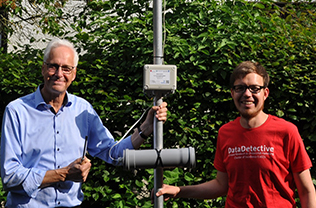How cold is it under thunderstorms? Measuring cold pools in Hamburg
These rapid and small-scale changes are the signature of a cold pool, an area of evaporatively cooled downdraft air, formed high in the cumulonimbus cloud, falling through the atmosphere and spreading at the Earth’s surface underneath precipitating clouds. They are important not only because of the damage they can cause, but also because they influence the life cycle of thunderstorms. The conventional ground measurement network, which its measuring stations once every 25 km, is not well suited to detect the structure and development of such spatially limited weather phenomena. The FESST@HH project now aims to remedy to this limitation, using a targeted measurement campaign in Hamburg with a much higher station density. The scientists want to gain a detailed insight into the structure of these cold pools, whose structure is well known from model simulations but not yet from nature.
At 102 stations deployed in the Hamburg area, measuring instruments on a three-meter-high pole are used. They are called APOLLOs (Autonomous Cold Pool Logger — see photo) and were developed by Prof Felix Ament´s research group. They measure temperature and air pressure once every second near the surface. Rapid changes in these quantities are used by the scientists to detect the cold pools.
Read more about the topic in an interview with Prof Felix Ament, Universität Hamburg and MPI-M.
Originally, the APOLLOs were to be distributed within a 20 km radius of DWD's Lindenberg site in Brandenburg in summer 2020 as part of the larger FESSTVaL measurement campaign. FESSTVaL stands for Field Experiment on Submesoscale Spatio-Temporal Variability in Lindenberg and was initiated by the Hans Ertel Centre for Weather Research (HErZ). Due to the corona pandemic, the field experiment in and around Lindenberg was postponed to the summer of 2021. Instead, given the travel restrictions and thanks to the help of private gardens and premises of municipal authorities, the APOLLOs have now been deployed in Hamburg. They have started measuring June 1st and already caught several cold pool events.
The findings will be used to (i) improve the representation of small-scale processes in numerical weather prediction models, (ii) test new measurement strategies, e.g. how close measurement devices must be located to each other to detect the processes, and (iii) test the findings from model simulations using the collected observational data.

More information:
Project FESSTVaL: http://fesstval.de/en/
FESST@HH: http://fesstval.de/en/fessthome-2020/fessthh-cold-pools
Contact:
Dr Cathy Hohenegger
Max Planck Institute for Meteorology
FESSTVaL – Steering Committee
Phone: +40 40 41173 302
Email: cathy.hohenegger@mpimet.mpg.de
Dr Sarah Wiesner
Universität Hamburg – Meteorological Institute
Project Coordinator FESSTVaL
Phone: +49 40 42838 5158
Email: sarah.wiesner@uni-hamburg.de
